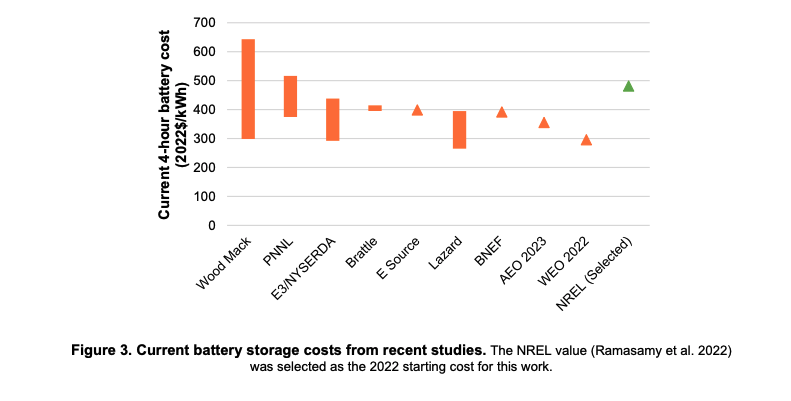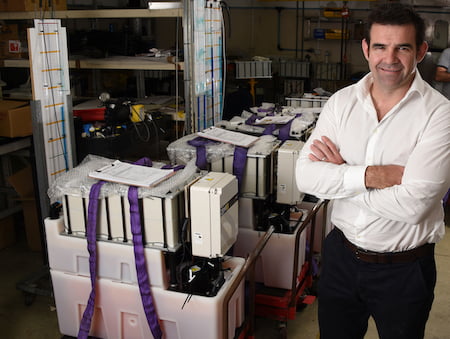Below is a vaguely categorised list of some of the things they’d have been able to learn more about. Last week in Part 1, we took a look at what some experts were saying about the show and the European market, which you can read here (Premium access).
Large-scale solutions
Ampt, JONSOL: Integrated DC-coupled energy storage for PV modules
US-headquartered DC power optimiser specialist Ampt has teamed up with German PV module manufacturer JONSOL to create what the pair claimed is the first optimised string inverter-based DC-coupled solar PV-plus-storage solution on the global market.
It combines Ampt’s DC-DC conversion String Optimizers, performing maximum power point tracking (MPPT) on every string of PV modules, with a bi-directional battery inverter and JONSOL modules.
Intilion: German manufacturer signs insurance deal with Munich Re
During the trade fair, Dr Sebastian Scholz, product lead for energy storage at insurance group Munich Re, signed a cooperation agreement with Dr. André Haubrock, CEO of energy storage solutions provider Intilion.
Under the long-term agreement, Munich Re provide Intilion with insurance against customer claims made under its solutions’ Product and Performance Warranty Insurance. Haubrock described it as “a seal of approval for the quality and longevity of our product,” which Munch Re offered “after a very rigourous testing process”.
“We are proud that the respected re-insurer has agreed to offer insurance covering the five-year warranty and 10-year performance guarantee that INTILION provides to its customers. This long-term approach gives our customers the necessary security and planning capability when using our large-scale storage solutions of up to 100MWh,” Haubrock said.
Intilion is a subsidiary of German battery company Hoppecke, producing battery energy storage system (BESS) solutions for segments including commercial and industrial (C&I) and large-scale. It recently won a 60MWh order from Deutsche Telekom subsidiary PASM Power and Air Condition Solution Management GmbH (PASM).
Distributed energy storage: residential, commercial and industrial (C&I)
While there were lots of large-scale solutions on show, most have been seen previously at other trade events, notably at SNEC 2023 in Shanghai, China. On our sister site, PV Tech, you can see exclusive video interviews and product showcases with many of the providers of those BESS solutions.
At ees Europe, while many of those were also there alongside large-scale solutions from many other companies, there was a big emphasis on serving the growing distributed storage market, as we can see below.
Sungrow: C&I solution wins award
Solar PV inverter and energy storage system provider and integrator Sungrow won this year’s ees Award with its PowerStack liquid cooled energy storage system for the C&I market.
Hosted by the Smarter-E show’s organisers, Solar Promotion, the ees Award 2023 was open to innovations across the entire energy storage value chain, from components to products up to business models and complete solutions.
Sungrow’s PowerStack is available with battery capacity ranging from 527kWh up to 1146kWh, for 2-hour and 4-hour applications. It includes integrated power conversion system (PCS), energy management system (EMS), fire suppression system, and of course lithium-ion batteries.
One of a growing number of liquid cooled systems now on the market, PowerStack also features AI-assisted cell monitoring, as well as four layers of overcurrent protection and anti-arc protection.
Sungrow’s ees Award 2023 winning PowerStack C&I solution. Image: Sungrow.
JinkoSolar launches HV residential battery
Vertically integrated PV module manufacturer JinkoSolar launched its second generation high-voltage energy storage battery for the residential and small commercial segments at the show.
JinkoSolar’s JKR-B1250~2750-A product includes the company’s own HV battery, boasting a single pack capacity of 3.84kWh capable of up to 6,000 daily cycles at room temperature. Scalable up to 134kWh, battery packs are connected wirelessly, with parallel connection between racks.
Kehua ‘all-in-one’ C&I system
Power management and inverter solutions company Kehua Tech launched an integrated ‘all-in-one’ C&I battery storage solution at the show in Germany.
Called S³-EStore, the system is liquid cooled, with Kehua claiming it can limit temperature variations in battery packs to within 2℃. It also has a perfluoro fire protection system, while the containerised version comes with built-in fire extinguisher.
Using LFP cells, the S³-EStore comes with 43kWh battery pack configuration, and energy capacity up to 215kWh per unit. Kehua claims it has one of the smallest footprints in the business, at just 1.3 metres squared.
Battery analytics
Regular readers of this site will have noticed a recent focus on battery analytics across our online, print and webinar offerings, as the industry rapidly wakes up to what analytics can do to ensure healthy, safe systems perform at their maximum potential.
TWAICE adds new models to battery simulation
Cloud-based battery analytics specialist TWAICE has expanded the scope of its battery simulation software to include electric-thermal ageing models. These are based on the German company’s own database of battery parameters, supplemented with data from customer testing as well as manufacturer data sheets.
The battery simulation model is aimed at enabling all-scenario tests of how battery cells will behave and perform. In addition to the simulation offering, TWAICE also provides support for customers throughout the lifetime of their BESS asset’s operation, as well as during commissioning – see our recent webinar with the company on the role of ‘digital commissioning’ for more on that.
ACCURE’s new features for Safety Manager solution
Fellow German predictive battery analytics company ACCURE has added various new features to Safety Manager, its “flagship” solution for battery safety, which it exhibited at ees Europe.
The solution accurately predicts problems with batteries well in advance of them escalating, ACCURE claimed, using cloud computing to process large amounts of battery data. More than 20 different anomalies relevant to safe operation can be detected and monitored, using what the company described as physics-based modelling as well as AI.
New features added include a “safety scoring system,” assigning batteries a safety score based on operational anomalies and associated patterns of errors. Safety Manager benchmarks those against historical data from systems operating in the field globally, representing these and other metrics in a visual interface ACCURE claims is user-friendly.
Other new features include the ability for the software to make recommendations based on the safety ratings gathered. These could include suggestions for planned maintenance scheduling, advance notice that a battery should be shut down, and more. Also added to the suite is a system of alerts.
E-mobility and energy storage
ADS-TEC: battery-integrated EV charging
German energy storage and e-mobility solutions company ADS-TEC showcased a number of new products at this year’s show, spanning the Power2Drive e-mobility exhibition as well as ees Europe and Intersolar Europe.
That range included another all-in-one C&I storage solution, as well as two energy-storage based fast charge solutions, called ChargeBox and ChargePost.
Both are claimed to offer ultra-fast charging capabilities, with integrated battery storage, power electronics and two charging points apiece. ChargePost can support charging for electric vehicles (EVs) with 1x 300kW or 2x 150kW charging, whereas ChargeBox has two separate 320kW ports, both of which can be split down to 2x 160kW.
ADS-TEC claimed both can be quickly and easily connected to existing grids without requiring grid upgrades, while ChargePost can hold storage capacity in reserve for connection and use in combination with other distributed energy resources (DER), such as solar PV systems.
Additionally, both solutions can be used to buffer electricity demand peaks for various other types of resource as well as, or instead of, EVs.
SolarEdge bi-directional EV charger
Solar PV power optimiser and energy management solutions provider SolarEdge showcased its DC-coupled EV charger, which can charge a vehicle simultaneously from solar PV, home batteries or AC grid at up to 24kW.
Meanwhile its bi-directional charge capability means it can provide vehicle-to-grid (V2G) and vehicle-to-home (V2H) charging. Based on SolarEdge’s own DC-coupling architecture, the solution can charge an EV directly from solar without conversion losses, and can be used with the company’s energy optimisation system, ONE, to charge and discharge in sync with dynamic utility pricing patterns.
Continue reading










